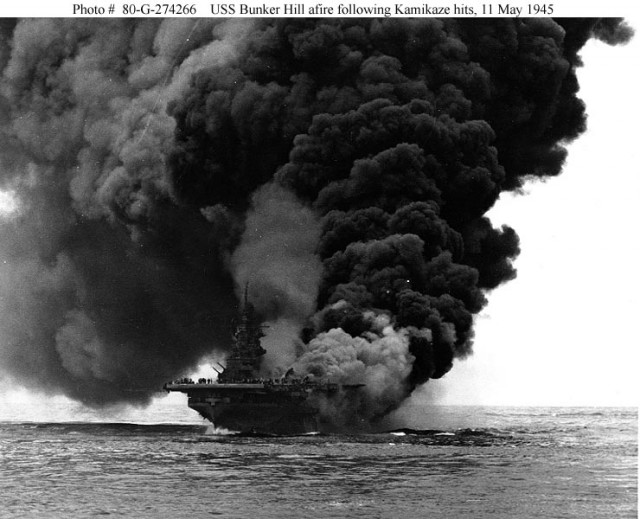During the Pacific campaign in WWII aircraft carriers were the prime targets in the fleet engagements fought between the USA (and later Britain) and Japan. At first massive carrier engagements took place where the carriers were damaged and sometimes sunk by torpedoes and bombs. Later in the war as the Japanese turned to ever desperate measures, the aircraft carriers were the target of Kamikaze airplanes.
What follows is a list of 6 fleet carriers that survived kamikaze attacks and were later repaired in put back into service. Many more escort carriers were hit and survived but fall outside the scope of this article.
USS Saratoga (CV-3)
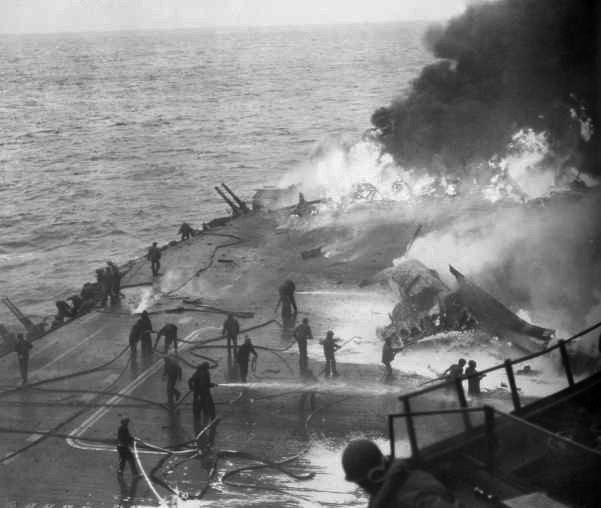
On February 21st, 1945, taking advantage of low cloud cover and Saratoga ’s weak escort, six Japanese planes scored five bomb hits on the carrier in three minutes; three of the aircraft also struck the carrier. Saratoga ’s flight deck forward was wrecked, her starboard side was holed twice and large fires were started in her hangar deck; she lost 123 of her crew dead or missing as well as 192 wounded.
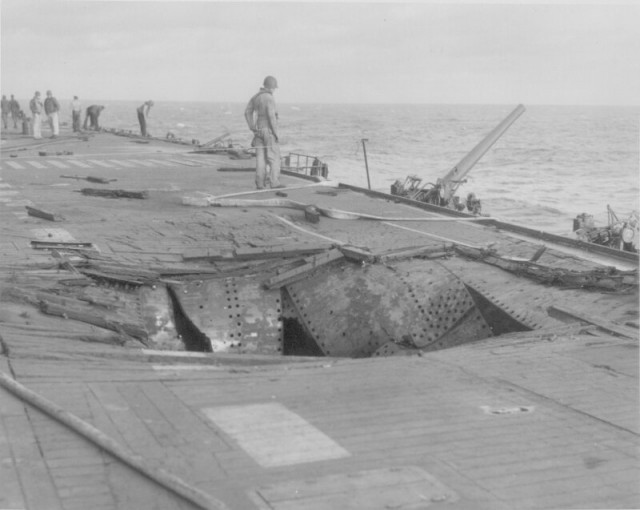
Thirty-six of her aircraft were destroyed. Another attack two hours later further damaged her flight deck. Slightly over an hour later, the fires were under control, and Saratoga was able to recover six fighters; she arrived at Bremerton on 16 March for permanent repairs.
USS Franklin (CV-13)
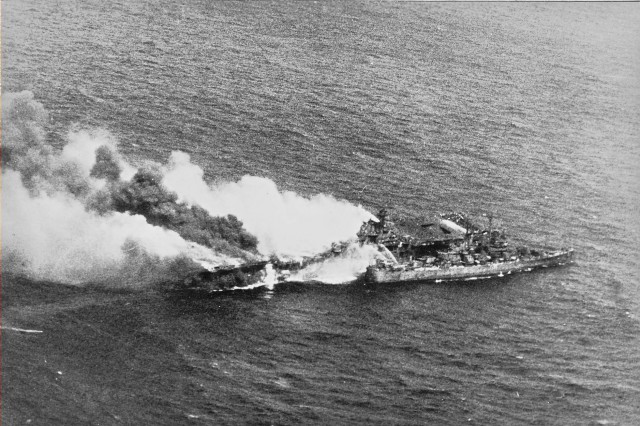
Before dawn on 19 March 1945, Franklin, which had maneuvered to within 50 miles of the Japanese mainland, closer than any other U.S. carrier during the war, launched a fighter sweep against Honshū and later a strike against shipping in Kobe Harbor.
Suddenly, a single aircraft pierced the cloud cover and made a low level run on the ship to drop two semi-armor-piercing bombs. The damage analysis came to the conclusion that the bombs were 550 pounds (250 kg). One bomb struck the flight deck centerline, penetrating to the hangar deck, effecting destruction and igniting fires through the second and third decks, and knocking out the Combat Information Center and air plot. The second hit aft, tearing through two decks.
Franklin lay dead in the water, took a 13° starboard list, lost all radio communications, and broiled under the heat from enveloping fires. Many of the crew were blown overboard, driven off by fire, killed or wounded, but hundreds of officers and enlisted who voluntarily remained saved their ship. A recent count brings the total 19 March 1945 casualty figures to 807 killed and more than 487 wounded.
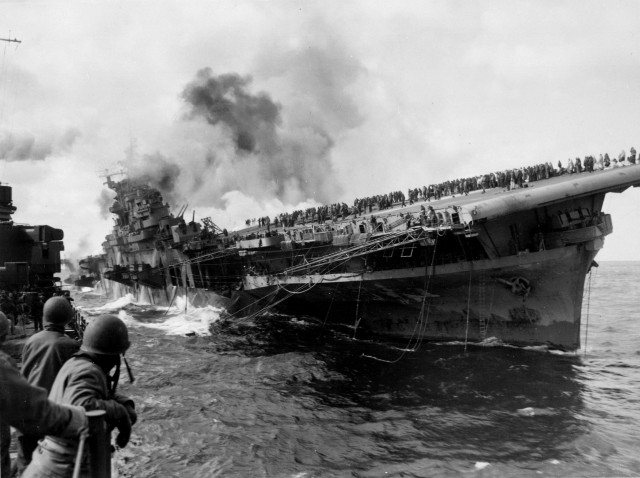
Franklin was taken in tow by the heavy cruiser Pittsburgh until she was able to raise enough steam to reach a speed of 14 kts, and then she proceeded to Ulithi Atoll under her own power for emergency repairs. Next, she steamed to Pearl Harbor, Hawaii, where repairs permitted her to steam to the Brooklyn Navy Yard, New York, via the Panama Canal, where she arrived on 28 April 1945.
USS Bunker Hill (CV-17)
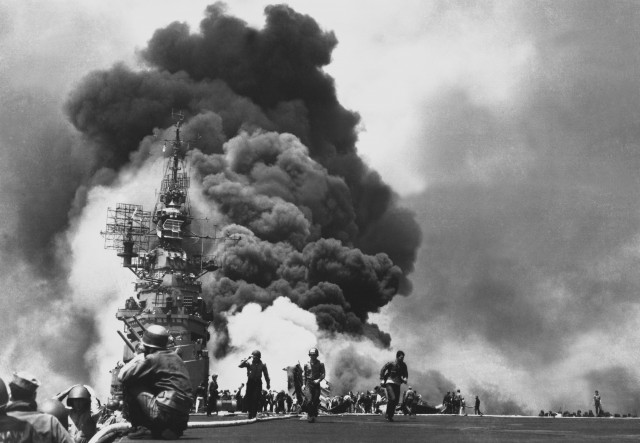
On the morning of 11 May 1945, while supporting the invasion of Okinawa, Bunker Hill was struck and severely damaged by two Japanese kamikaze planes. An A6M Zero fighter plane piloted by Lieutenant Junior Grade Seizō Yasunori emerged from low cloud cover, dove toward the flight deck and dropped a 550-pound bomb that penetrated the flight deck and exited from the side of the ship at gallery deck level before exploding in the ocean.
The Zero next crashed onto the carrier’s flight deck, destroying parked warplanes full of aviation fuel and ammunition, causing a large fire. The remains of the Zero went over the deck and dropped into the sea. Then, a short 30 seconds later, a second Zero, piloted by Ensign Kiyoshi Ogawa, plunged into its suicide dive. The Zero went through the antiaircraft fire, dropped a 550-pound bomb, and then crashed into the flight deck near the carrier’s “island”, as kamikazes were trained to aim for the island superstructure.
The bomb penetrated the flight deck and exploded. Gasoline fires flamed up and several explosions took place. Bunker Hill lost a total of 346 sailors and airmen killed, 43 more missing (and never found), and 264 wounded. She was heavily damaged and was sent to the Bremerton Naval Shipyard for repairs. She was still in the shipyard when the war ended in mid-August 1945.
Continues on next page
USS Enterprise (CV-6)
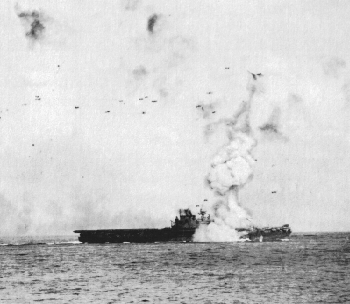
11 April 1945 – Hit by a Yokosuka D4Y3 Suisei “Judy” right aft, with its 500 kg bomb exploding at the turn of the bilge near the after machinery spaces, causing severe shock damage. An hour later, another D4Y3 kamikaze near-missed near her starboard bow and its bomb went off close aboard, causing some additional underwater damage. Five men were wounded from these attacks and one man was blown overboard, but later rescued. Enterprise continued with her flight duties, launching strikes on Okinawa and islands in the Amami group for three more days before being detached. She was repaired at Ulithi for sixteen days and was off Okinawa once more on 6 May.
14 May 1945: The “Big E” suffered her last wound of World War II when a bomb-laden Mitsubishi A6M Zero “Zeke” fighter flown by Chief Pilot Tomi Zai destroyed her forward elevator, killing 14 and wounding 34 men. The bomb penetrated to the third deck where it detonated in a rag storeroom. A large fire was started in the elevator pit and among the deck park aircraft. The carrier sailed for repairs at Puget Sound Navy Yard, arriving 7 June 1945. Repairs were slowed by the end of the war but completed on 13 September 1945 at which time she was “restored to peak condition” according to her DANFS entry. She never operated aircraft again but took part in “Operation Magic Carpet” before she was decommissioned on 17 February 1947.
HMS Formidable (67)
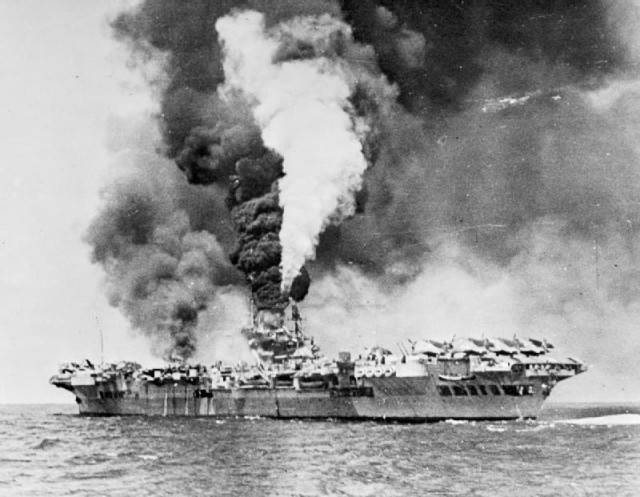
On May 4th the HMS Formidable had just launched two Corsairs for bombardment-spotting duties and the deck park of eleven Avengers was being moved forward to allow aircraft to land when an undetected Mitsubishi A6M Zero fighter attacked at 11:31. The Zero first strafed the flight deck before any of Formidable ’s guns could open fire and then turned sharply to dive into the forward flight deck despite the ship’s hard turn to starboard. The fighter released a bomb shortly before it would have impacted the deck and was destroyed by the bomb’s blast, although the remnants of the Zero struck Formidable.
The detonation of the bomb blew a 2-by-2-foot hole in the flight deck. It killed 2 officers and 6 enlisted men, wounding 55 other crewmen.A fragment from the flight deck armour penetrated the hangar deck armour and passed through the centre boiler uptakes, the centre boiler room itself, and an oil tank before it came to rest in the inner bottom. The fragment severed the steam pipes in the centre boiler room and forced its evacuation, cutting the ship’s speed to 14 knots.
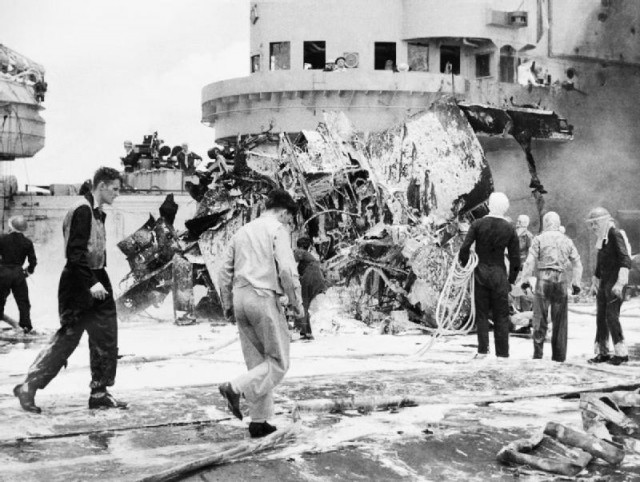
The blast on the flight deck blew the Avenger closest to it over the side and set another one on fire. Shrapnel from the blast peppered the island, causing the bulk of the casualties, and severed many electrical cables, including those for most of the ship’s radars. The fires on the flight deck and in the hangar were extinguished by 11:55, and seven Avengers and a Corsair which were damaged beyond repair were dumped over the side. The bomb struck at the intersection of three armour plates and dented the plates over an area 20 by 24 feet. The dent was filled by wood and concrete and covered by thin steel plates tack-welded to the deck so that she was able to operate aircraft by 17:00 and steam at a speed of 24 knots.
Thirteen of her Corsairs had been airborne at the time of the attack and they operated from the other carriers for a time. The damage to the boiler room and its steam
USS Ticonderoga (CV-14)
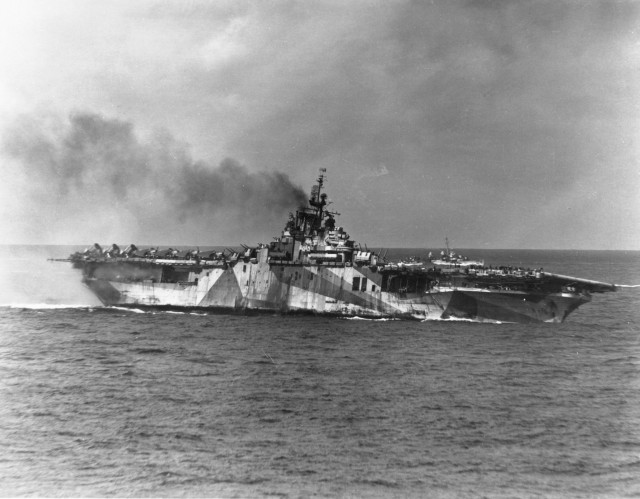
Just after noon on January 21st 1945, a single-engine Japanese plane scored a hit on Langley with a glide-bombing attack. Seconds later, a kamikaze swooped out of the clouds and plunged toward Ticonderoga. He crashed through her flight deck abreast of the No. 2 5inch mount, and his bomb exploded just above her hangar deck. Several planes stowed nearby erupted into flames. Death and destruction abounded, but the ship’s company fought valiantly to save the threatened carrier.
Captain Kiefer conned his ship smartly. First, he changed course to keep the wind from fanning the blaze. Then, he ordered magazines and other compartments flooded to prevent further explosions and to correct a 10° starboard list. Finally, he instructed the damage control party to continue flooding compartments on Ticonderoga ’s port side. That operation induced a 10° port list which neatly dumped the burning planes overboard. Firefighters and plane handlers completed the job by dousing the flames and jettisoning burning aircraft.
The other kamikaze then pounced on the carrier. Her antiaircraft gunners struck back with ferocity and quickly shot three down into the sea. A fourth plane slipped through her barrage and smashed into the carrier’s starboard side near the island. His bomb set more planes on fire, riddled her flight deck, and injured or killed another 100 sailors, with Captain Kiefer one of the wounded. Yet Ticonderoga ’s crew refused to submit. Spared further attacks, they brought her fires completely under control not long after 1400; and Ticonderoga retired.
The stricken carrier arrived at Ulithi on 24 January but remained there only long enough to move her wounded to hospital ship Samaritan, to transfer her air group to Hancock, and to embark passengers bound for home. Ticonderoga cleared the lagoon on 28 January and headed for the U.S. The warship stopped briefly at Pearl Harbor en route to the Puget Sound Navy Yard where she arrived on 15 February. Captain William Sinton assumed command in February 1945.

